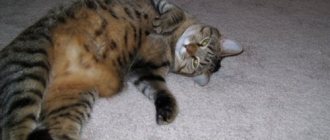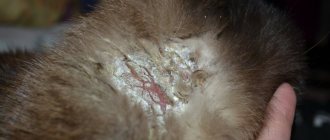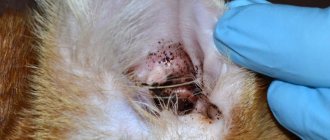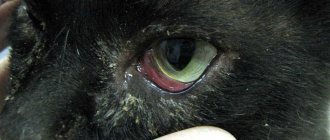Causes
Renal failure is understood as a syndrome that occurs against the background of concomitant diseases affecting the genitourinary system. Such diseases include nephrosis, pyelonephritis, urolithiasis and other kidney pathologies. Kidney failure can develop as a complication of diabetes mellitus, pneumonia, vasculitis, leptospirosis, etc.
There are often cases when a cat’s genitourinary system suffers due to poisoning with toxic substances, which occurs, for example, as a result of long-term use of medications. The load on the kidneys increases, as they try to fulfill their direct responsibility as quickly as possible - to remove poison from the body. This can lead to serious consequences, including organ destruction.
Finally, a factor that provokes kidney failure may be your furry's genetic predisposition to certain diseases, for example, polycystic disease, glomerulonephritis.
Renal failure is characterized by two forms of the disease: acute and chronic.
Acute failure is the most dangerous, as in most cases it ends in death. It proceeds rapidly and has a pronounced clinical picture. ARF, in turn, also occurs in three forms: prerenal, renal, postrenal.
Veterinarians say that the most serious form is renal. Regarding prerenal and postrenal, the prognosis is rather favorable.
In chronic renal failure, the kidneys gradually cease to perform excretory functions. For a long time, chronic renal failure may not manifest itself at all. This is why she is dangerous. Kidney cells die gradually, the load is redistributed between healthy cells, but then they die.
Damaged tissues become scarred, causing the kidneys to decrease in size and no longer cope with their duties. As a rule, chronic renal failure is diagnosed in older cats.
CRF has four stages: latent, initial, conservative, terminal.
The latent form has the greatest chance of a favorable outcome, but timely diagnosis occurs in the rarest cases. In case of terminal illness, unfortunately, it is no longer possible to help the animal, so the only way to stop the pet’s suffering is euthanasia.
Why is an organ so important to an animal?
Kidney failure is a condition in which the kidneys fail to flush out toxins from the body and lead to fluid imbalance.
The disease manifests itself with kidney damage up to 80%. Urine becomes almost colorless, which indicates that it does not remove toxic substances from the body. Representing a paired organ, the kidneys carry out the work of purifying the blood. Healthy organs contribute to the elimination of metabolic products and toxic substances formed in the body of carnivores. The kidneys are also involved in hematopoiesis. Therefore, nephrological diseases are accompanied by severe intoxication of the animal, disturbances in electrolyte, water and protein metabolism and are the cause of death in 20% of furry pets.
It is believed that domestic cats are susceptible to kidney pathology due to genetic predisposition. In addition, cats have a long but narrow urinary canal, which often contributes to blockage and inflammation. This especially affects cats, whose urinary system is even narrower than that of females.
Symptoms
If we are not talking about an acute form of renal failure, then for a long period the pathology occurs in a latent form. Gradually the cells die, but the kidneys continue to work. Characteristic signs of renal failure appear when the volume of damaged tissue is more than 70%.
A cheerful and active pet becomes lethargic, sleepy, gets tired quickly and lies down most of the time. His appetite disappears, and his thirst, on the contrary, increases. Despite drinking a lot of water, the cat rarely goes to the toilet. Even if he manages to pee, the amount of urine is insignificant. The owner notices that the fluffy is constantly licking the genitals.
Then there are digestive disorders - nausea, diarrhea, constipation.
The appearance of a sharp unpleasant odor from the body and mouth of a four-legged pet is typical.
In severe cases, the animal experiences epileptic seizures, convulsions, fever, hypertension, which results in rupture of blood vessels in the eyeball and loss of vision. Intoxication of the body increases, the cat’s condition rapidly deteriorates. The kidneys do not work, causing the pet to fall into a coma and die.
Types of kidney failure
— acute — with acute renal failure it is possible to restore kidney function;
- chronic - kidney tissue degenerates into connective tissue. The process is irreversible; the kidneys do not restore function.
- to renal. The cause of kidney dysfunction is impaired blood supply due to severe dehydration or prolonged exposure to anesthesia.
- after renal. It occurs against the background of an abnormal outflow of urine caused by urolithiasis (blockage of the urinary tract).
- actual renal failure. Occurs after poisoning with a toxic substance and is a consequence of chronic diseases (in particular, chronic kidney inflammation).
Diagnostics
Diagnosing renal failure is associated with certain difficulties. It can be carried out qualitatively only in a hospital, using instrumental and laboratory methods.
First of all, blood biochemistry is carried out. The study allows you to find out the level of phosphorus, potassium, creatinine, and urea.
A lot of information can be obtained from a laboratory urine test, in particular, it indicates a change in the composition of the biological fluid, determines the level of leukocytes, the presence of bacteria and renal epithelium. The urine of a sick cat is dark or, conversely, too light and has low density. The content of red blood cells and protein is increased.
An ultrasound of the kidneys is required. It shows the structure of the organ, its location and shape, and the presence of cysts.
To determine the area of kidney damage, radiography with a contrast agent is performed.
The most accurate information is provided by computed tomography of the kidneys. But due to its high cost, it is used in rare cases.
Features of tricuspid insufficiency grade 2
Tricuspid valve insufficiency is a failure of the valve apparatus, in which incomplete closure of the leaflets occurs and, as a result, regurgitation occurs. There are several degrees of severity of this pathology.
Tricuspid insufficiency occurs due to various diseases and exposure to damaging factors on the body. The most common reasons are:
- Inflammation of a systemic nature - rheumatism.
- Infectious lesion of the inner layer of the heart.
- Inflammation of the muscle layer of the heart.
- Myocardial infarction with predominant damage to the right ventricle.
- Sclerotic changes in the vessels of the heart muscle.
- Carcinoid tumors.
- Chest injuries with damage to the valves.
- Chronic heart failure.
- VSD (ventricular septal defect).
- Complications of some heart surgeries.
Classification
Tricuspid insufficiency, depending on various criteria, is divided into numerous forms. Depending on the time of occurrence, congenital and acquired deficiency differs.
Depending on which part of the valve is affected, the following forms are distinguished:
- organic failure is characterized by damage to the valves themselves;
- the functional (relative) form occurs due to damage to other elements of the valve apparatus.
Grade 1 – regurgitation is almost invisible.
Grade 2 - reverse blood flow is noticeable 20 millimeters from the valve apparatus.
Grade 3 – throw is determined more than 20 millimeters from the valve flaps.
Grade 4 – significant regurgitation over a large volume.
This classification is very important. Determining the form of the pathology will help you choose the right treatment.
Symptoms of the defect
Tricuspid insufficiency of the 2nd degree is manifested by hypertension and enlargement of the atrium (compensation of the heart muscle). When the body exhausts the ability to compensate for the heart, decompensatory phenomena develop, due to which symptoms arise.
With a first degree defect, symptoms do not appear due to compensation. The patient does not have any complaints.
Tricuspid valve insufficiency of the 2nd degree leads to a noticeable deterioration in the general condition of a person, in contrast to pathology of the 1st degree, which in some cases is a variant of the norm. This pathological condition leads to weakening of the right parts of the heart, which is why the course of the disease actually worsens and damage to organs and systems occurs. When transitioning from grade 2 to grade 3, it is necessary to correct the defect (surgery) as quickly as possible.
The clinical picture of this pathology includes the following symptoms:
- A person's performance decreases. He complains of weakness and fatigue during physical work.
- Patients usually note irregular heartbeat. They feel a heartbeat with irregular rhythm.
- There is frequent urination at night (nocturia).
- In the afternoon, swelling in the lower extremities becomes noticeable, which may subside slightly the next morning.
- A person experiences discomfort due to constant freezing of his feet. They are cold to the touch even in a warm room.
- Discomfort and heaviness in the liver.
- Impaired respiratory function (shortness of breath).
- Swollen vessels of the neck are revealed, which palpably pulsate.
- Complaints of bloating, nausea and vomiting.
All these symptoms are characteristic of the progression of this pathological condition. If treatment is not carried out, then the person experiences complications:
- PE (pulmonary embolism). A thrombus, breaking away from its attachment site, can partially or completely block the lumen of the pulmonary vessels. This condition develops acutely, it is very life-threatening for the patient and requires emergency care.
- Heart rhythm disturbances (eg, atrial fibrillation).
- Secondary infection of the endocardium.
In children, as a rule, this defect does not occur in its pure form. It is combined with pathology of other valves.
If grade 2 tricuspid insufficiency occurs in a newborn, then he experiences rapid development of cardiac and respiratory failure. Very often this condition leads to the death of the baby.
The acquired form of the defect occurs as a complication of previous infectious diseases, injuries and malignant neoplasms.
Tricuspid insufficiency in children leads to congestion in the pulmonary and systemic circulation. This, in turn, is manifested by a violation of the functions of organs and systems of a small organism.
The first degree of pathology is an indication for monitoring the child; in case of a more severe course of the disease, treatment is provided, both medicinal and surgical.
The sooner a pathology of the valve apparatus is detected, the easier it will be to eliminate it. In this case, the child’s chances of leading a full life in the future increase.
Diagnostic measures are aimed at identifying pathology and assessing the degree of its severity. When a patient first contacts, it is necessary to collect a thorough medical history. It is necessary to ask about past illnesses both the patient himself and his blood relatives. After which it is necessary to begin a physical examination.
You can visually assess the color of the skin. There is a yellow color of the skin due to pathological effects on the liver. For the same reasons, an increase in the size of the abdomen (ascites) is determined. Free fluid accumulates in the abdominal cavity, which affects the internal organs. It is also necessary to measure your blood pressure level.
By palpation, you can determine liver enlargement, swelling and irregular heartbeat when palpating the pulse.
Percussion reveals changes in the boundaries of the heart and liver.
Auscultation helps to listen to the characteristic heart murmur and irregular heartbeat.
Laboratory research methods are necessary to detect concomitant pathologies and complications of this defect:
- Laboratory examination of urine and blood.
- Biochemical blood test.
- Immunological analysis.
Instrumental research methods:
- An ECG helps assess the size of the heart's chambers and its functionality. According to the results of the electrocardiogram, hypertrophy of the right chambers of the heart and signs of arrhythmia are revealed.
- Phonocardiography will help identify the characteristic (systolic murmur).
- Ultrasound of the heart muscle is a more accurate and accessible method for diagnosing diseases of the cardiovascular system. Using Doppler echocardiography, the degree of regurgitation is revealed, that is, the return of blood into the atrium at a distance of less than two centimeters from the valve apparatus. Hypertrophic changes and hypertension of the right heart are determined.
- X-ray of the chest organs. Using this research method, pathological changes in the size of the heart and its position are determined.
- CT (computed tomography) helps to obtain images of the heart in different projections.
- MRI (magnetic resonance imaging) allows you to evaluate the heart muscle layer by layer and identify concomitant pathology.
Diagnosis of this type of pathology is quite labor-intensive and varied due to the combination of defects and the development of complications in the organs of the systemic circulation.
Determining the type and tactics of treatment will depend on the severity of the defect, the cause of its occurrence, concomitant pathologies and complications that arise. As a rule, for grade 2 tricuspid valve pathology, two treatment methods are combined:
- conservative treatment (medication);
- surgical (operative) treatment.
Treatment
Kidney failure is one of the incurable pathologies. However, with the help of a well-designed treatment regimen, it is possible to maintain the animal’s quality of life and achieve some improvement in kidney function.
The cat will be under the supervision of a veterinarian for life and will undergo regular examinations, including urine and blood tests. In addition, the animal will have to follow a therapeutic diet and take certain medications for the rest of its life.
Treatment depends on the form of renal failure, the general condition and age of the animal.
The acute form is treated according to a regimen that includes:
- elimination of the factor that provoked the deficiency;
- restoration of water balance;
- hemodialysis (artificial blood purification);
- removal of intoxication;
- decreased blood pressure;
- special medical nutrition.
In case of chronic insufficiency, therapeutic measures are aimed at restoring the acid-base, water-salt balance, and stabilizing blood pressure. Elimination of signs of anemia. It is necessary to undergo hemodialysis and use a strict but nutritious and balanced diet.
To improve immunity, it is advisable to use vitamin and mineral complexes.
Diet
Diet plays a leading role in the treatment of any form of renal failure. Last for at least 6-9 months, it is prohibited to switch to regular cat food immediately after the symptoms pass!
After returning home, the animal should rest more time and move less.
The success of therapy depends not only on the recommendations of the veterinarian and prescribed medications, but also on the owner who will care for the pet at home. After the heart attack has been suffered, the cat will need to create conditions of complete rest.
The animal is sent to a quiet and dark room where it will not be disturbed by other pets or children. It is important to protect the cat from stressful situations. In addition, owners should ensure that the cat's activity is limited.
Veterinarian Andrei Gennadievich Komolov recommends walking the animal on the street, where the environment is calm and familiar. Walks should be short so that the animal does not get tired. In addition, you will definitely need to change the cat's diet.
The menu includes foods that are easily digestible. It is forbidden to give cats fatty foods; it is better to avoid using dry food, which is sold in stores. The diet is enriched with fermented milk products.
If the kitten is small, it is acceptable to give it milk. For older animals, low-fat cottage cheese and sour cream are suitable. In addition, it is allowed to feed cats fish, but in limited quantities. Lean types of meat - chicken, beef - will be useful.
You can add cereals to your diet, such as rice and buckwheat. You will need to cook them in weak broth or water. It is forbidden to give pets fatty meats, smoked meats, and sweet foods. If the veterinarian allows it, it is permissible to give the animal easily digestible complementary foods.
What to do at home
The owner must strictly follow the veterinarian's instructions. Self-medication and replacement of traditional methods of conservative treatment lead to detrimental consequences.
A sick pet needs to be provided with quality care and therapeutic nutrition. The diet lasts for at least six months. At this time, salt, sea fish, fatty meats, offal, cereals, and dairy products are completely excluded from the cat's menu. Flour products and fish oil are prohibited.
The diet consists of poultry (chicken, turkey), broth, vegetables (cabbage, carrots). There are few acceptable products, so veterinarians recommend giving preference to special medicinal dry food.
A product from Royal Canin, Renal food, developed for cats with renal failure, received high marks from experts. It includes all the vitamins and nutrients your cat needs during intensive care.
Kidney diseases in cats and kittens
Kidney diseases can be acute or chronic, congenital or acquired.
Hereditary (genetic) kidney diseases are characteristic of certain breeds, for example, renal amyloidosis (a disorder of protein-carbohydrate metabolism with the deposition of amyloid, a protein-polysaccharide compound, in the kidney tissue) occurs in cats of the Abyssinian and Somali breeds, and polycystic disease (appears in the kidneys and gradually increases cysts) – in Persian, Himalayan and exotic cats.
Congenital anomalies also include renal aplasia (one or both kidneys are missing at birth) and renal dysplasia (abnormal development of the kidneys).
Acute diseases appear suddenly, for example, as a result of abdominal trauma, large blood loss or dehydration, blockage of the urethra, infection, poisoning (antifreeze is especially dangerous). They require intensive treatment of both the organ itself and the cause of its damage. If the disease is caught at the very beginning, the prognosis is favorable.
Chronic diseases develop gradually and require constant maintenance therapy. Usually progress over time and eventually lead to a sad end.
There is a very fine line between these types of diseases. The acute form can quickly turn into chronic!











